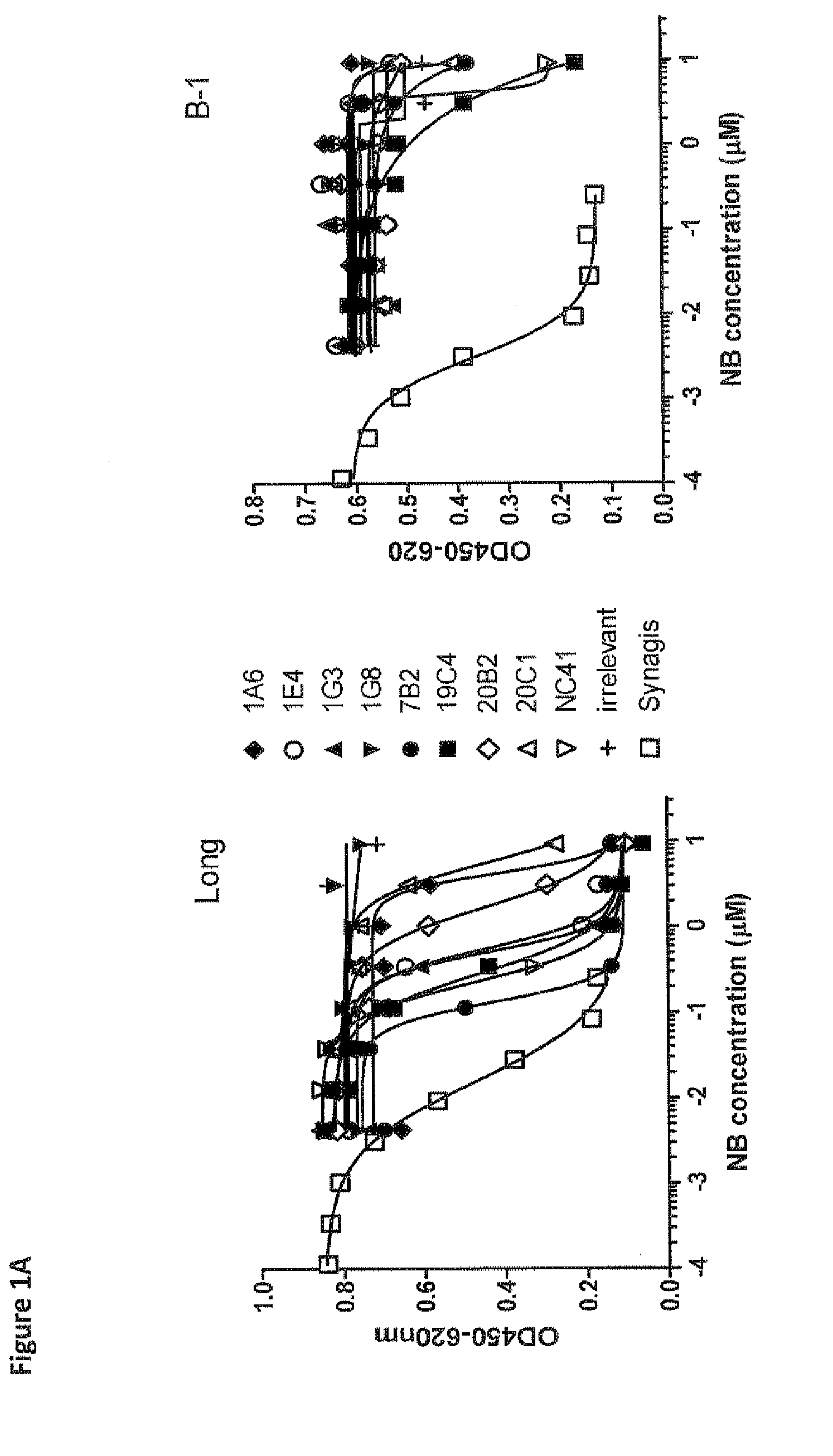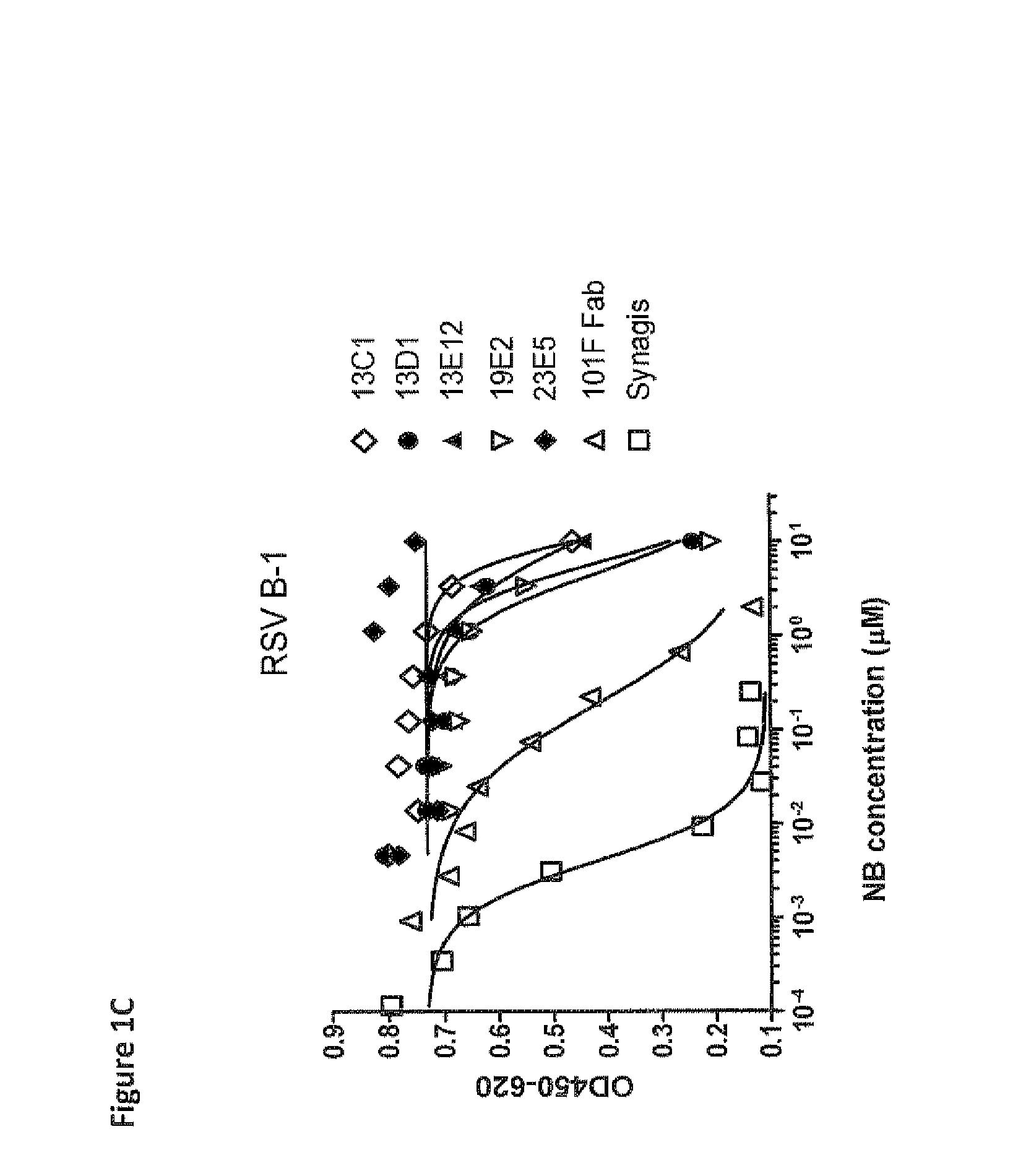Amino acid sequences directed against human respiratory syncytial virus (HRSV) and polypeptides comprising the same for the prevention and/or treatment of respiratory tract infections
a technology of respiratory tract infection and amino acid sequences, which is applied in the field of amino acid sequences, can solve the problems of severe hrsv disease risk, poor prophylactic and/or pharmacological properties, and inability to prevent re-infection, so as to improve the ease of preparation, improve the prophylactic and therapeutic effects, and reduce the cost of goods
- Summary
- Abstract
- Description
- Claims
- Application Information
AI Technical Summary
Benefits of technology
Problems solved by technology
Method used
Image
Examples
example 1
Immunizations
[1706]Two llamas (156 and 157) were immunized according to standard protocols with 6 boosts of hRSV FTM-NN (membrane anchorless form of the fusion protein, 70 kDa; Corrall T. et al. 2007, BMC Biotechnol. 7: 17). Blood was collected from these animals 7 days after boost 6 and 10 days after boost 6. Two llamas (212 and 213) were immunized intramuscularly in the neck with 1 mg of RNA-inactivated RSV strain long A (Hytest, Turku Finland; #8RSV79), followed by 4 boosts of 0.5 mg RSV in a biweekly regimen. Two llamas (206 and 207) were immunized intramuscularly with 1 mg of RNA-inactivated RSV strain long A, boosted with 0.25 mg of RSV after 2 weeks, followed by 3 boosts with 50 μg of recombinant hRSV FTM-NN (membrane anchorless form of the fusion protein, 70 kDa: Corral et al. 2007; BMC Biotechnol. 7: 17) in a biweekly regimen. For all immunizations the antigens were prepared as oil-PBS emulsions with Stimune as adjuvant. Blood was collected from these animals 4 days and 10 ...
example 2
Library Construction
[1707]Peripheral blood mononuclear cells were prepared from blood samples using Ficoll-Hypaque according to the manufacturer's instructions. Next, total RNA was extracted from these cells as well as from the lymph node bow cells and used as starting material for RT-PCR to amplify Nanobody® encoding gene fragments. These fragments were cloned into phagemid vector derived from pUC119 which contains the LacZ promoter, a coliphage pill protein coding sequence, a resistance gene for ampicillin or carbenicillin, a multicloning site and the gen3 leader sequence. In frame with the Nanobody® coding sequence, the vector codes for a C-terminal c-myc tag and a (His)6 tag. Phage was prepared according to standard methods and stored at 4° C. for further use, making phage libraries 156, 157, 206, 207, 212 and 213.
example 3
Nanobody® Selection with the F-Protein of hRSV
[1708]To identify Nanobodies® recognizing the fusion protein of RSV, libraries 156, 157, 206, 207, 212 and 213 were used for selection on FTM-NN (membrane anchorless form of the Long fusion protein, 70 kDa; Corral T. et al. 2007, BMC Biotechnol. 7: 17). In addition, selections were done using inactivated hRSV strain Long (Hytest #8RSV79). The FTM-NN protein (25 ng / well) or RSV 5-0.5 μg / well) was immobilized on Nunc Maxisorp ELISA plates, next to a control with 0 μg / ml antigen. Bound phages were eluted using trypsin or 101F Fab (WO 06 / 050280, humanized monoclonal antibody, in-house produced) in 100 molar excess in consecutive first and second round of selections. As control for 101F Fab served Omnitarg Fab (anti-Her2; in-house produced). In order to identify Nanobodies® binding specifically to antigenic sites IV-VI epitopes on the RSV F-protein, outputs from the first round selections on FTM-NN eluted with 101F Fab were used for second ro...
PUM
| Property | Measurement | Unit |
|---|---|---|
| KA | aaaaa | aaaaa |
| KA | aaaaa | aaaaa |
| molar concentration | aaaaa | aaaaa |
Abstract
Description
Claims
Application Information
 Login to View More
Login to View More - R&D
- Intellectual Property
- Life Sciences
- Materials
- Tech Scout
- Unparalleled Data Quality
- Higher Quality Content
- 60% Fewer Hallucinations
Browse by: Latest US Patents, China's latest patents, Technical Efficacy Thesaurus, Application Domain, Technology Topic, Popular Technical Reports.
© 2025 PatSnap. All rights reserved.Legal|Privacy policy|Modern Slavery Act Transparency Statement|Sitemap|About US| Contact US: help@patsnap.com



